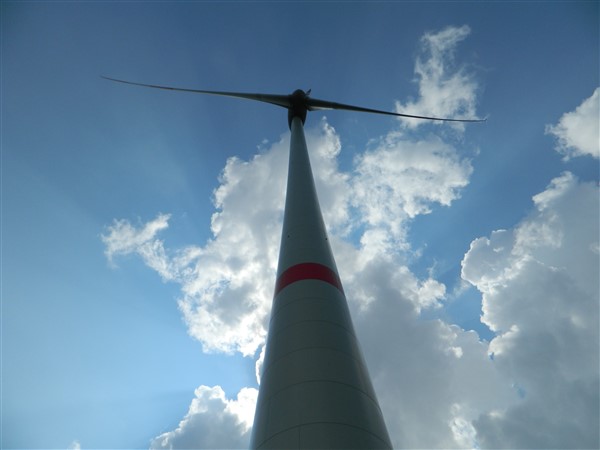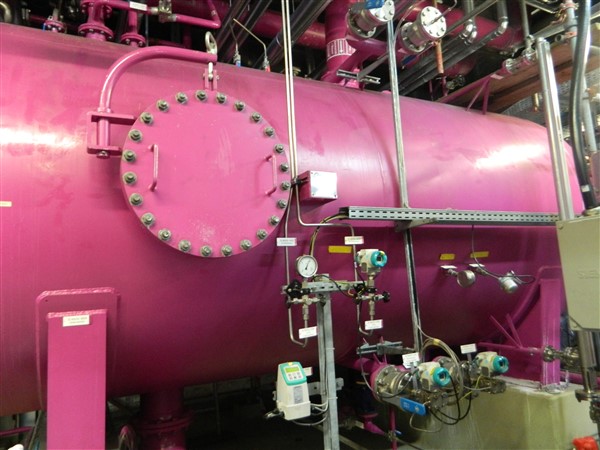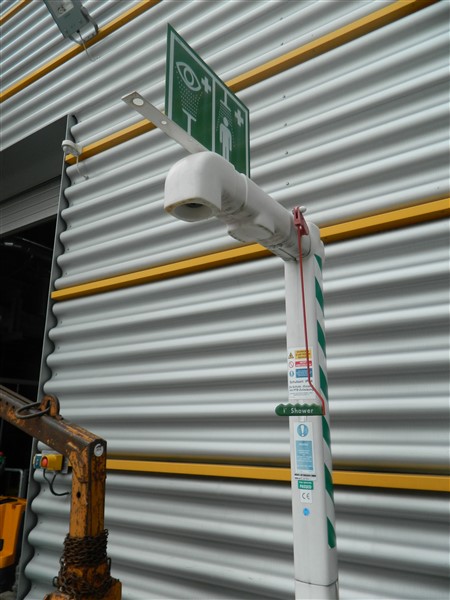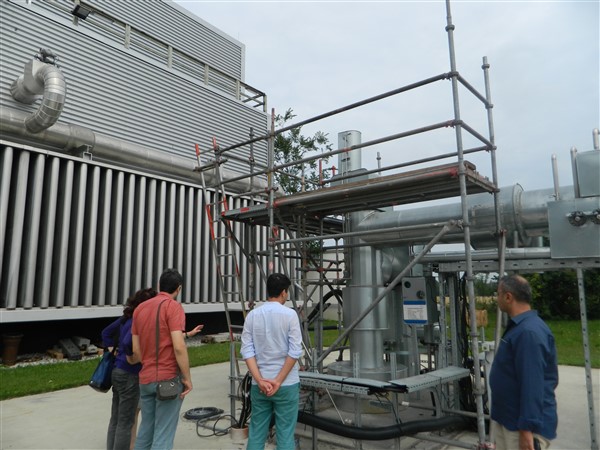Project on Increasing the Utilization of Renewable Energy Sources and Efficiency in Energy Use in South-eastern Anatolia Region
- Home
- Project on Increasing the Utilization of Renewable Energy Sources and Efficiency in Energy Use in South-eastern Anatolia Region
-
Activities Carried out with the Technical Support of United Nations Development Programme (UNDP)
Project Starting and Ending Dates According to Investment Schedule: 2009-2017

Justification: Reducing negative impact on environment and human health to minimum by ensuring more rational utilization of limited natural resources; diversifying energy utilization through new technologies in addition to new resources; phasing in alternative sources of energy in most useful ways and supply more efficient, cleaner, safer, less costly, accessible and sustainable energy.
Goal: Transforming South-eastern Anatolia Region into “Cradle of Civilizations” on the basis of a unique value proposal envisaging the utilization of the potential of renewable energy sources fully.
Objective: Transforming the GAP into a centre of high-tech and sustainable industry on the basis of renewable energy sources, with its information technologies, logistics and centres capable of serving to other provinces as well, also with its unique advantages and capacities in tourism as well.
Activities Conducted:
The project document of the project carried out with technical support from the UNDP was undersigned by the Ministry of Foreign Affairs, UNDP and GAP-RDA. There was also a Cost Sharing Agreement acted by the UNDP and GAP-RDA. As the first step a national and international team of advisors was set up to work for the project. This team started its work with a detailed situation analysis first, followed by a Starting Report, Action Plan and Strategic Action Plan.
Priority projects were identified with due account of their economic and technical feasibility as well as relevant international practices to enhance GAP Region’s development and competitiveness. In 2012 the second phase of the project was started, a series of integrated pilot projects in relation to renewable energy and energy efficiency were developed and put into implementation.
-
The work on establishing a Renewable Energy and Energy Efficiency R&D Centre at the campus of Harran University is in progress.
-
The work on the establishment of an Energy Efficiency Consultancy (EEC) Incubation Centre in Gaziantep for firms is in progress. In this context, a protocol of cooperation was acted by the GAP Administration, Gaziantep Chamber of Industry and Gaziantep, related candidates were given training, measurement devices were delivered to laboratories of common use and work for building restoration and company establishment was completed. Further, following measurements and modelling after restoration work the GAP EEC and Incubation Centre building was awarded EnerPHit certificate.
-
Sound and heat insulation work in the building of Şanlıurfa Regional Court was completed as a part of the initiative to improve energy efficiency in buildings.
-
Five pilot locations were identified for the establishment of Solar Energy Micro Irrigation Systems, in four of these locations systems were established together with their remote measurement and monitoring systems, and relevant analyses were completed.
-
Technical analysis of tourism facilities in the region was conducted within the framework of the concept of carbon-neutrality; work was deepened in three hotels with high potential of reducing carbon footprint and reports of analysis were completed.
-
Another technical analysis work was carried out in industrial enterprises active in the GAP region to identify their energy needs on sector basis. Preliminary studies were completed with field visits to 38 industrial establishments in the provinces of Gaziantep, Şanlıurfa, Diyarbakır, Adıyaman and Kilis.
-
On 7 October 2015 a protocol of cooperation was acted by the GAP Administration and Silk Road, Karacadağ and Dicle Development Agencies in the context of joint financial support programme for energy efficiency pilot practices in industry in line with findings obtained from preliminary studies in industrial establishments. The call for offers under the EE in industry joint financial support programme was given start in March 2016 following the approval of the Ministry of Development and implementation process is presently going on.
-
A region wide data gathering work was carried out to identify the potential of producing energy from agricultural and animal waste.
-
A feasibility study was made in Oğuzeli District of Gaziantep to produce energy from animal waste.
-
Analyses were made in Şanlıurfa and Bismil/Diyarbakır for possibilities of producing energy from pellet. In Bismil/Diyarbakır an herbal pellet production and marketing cooperative was established and a protocol was acted to support the cooperative. The tendering process for procurement of machinery and equipment was completed. The facility is expected to start operating in the first half of 2017.
-
Existing needs in the fields of renewable energy and energy efficiency of enterprises existing in the region were identified and an institutional capacity building action plan was developed. Various training activities, workshops and meeting followed in line with this plan.
-
Various networking initiatives at international level.
-
Awareness building in students and public on issues related to renewable energy and energy efficiency.

-
Activities with Other Institutions
-
Project on the Establishment of “Animal Waste Based Model Biogas Facility”
Starting and Ending Dates: 16.12.2015- 16.12.2017
Project Duration: 2 years
Funding Source: National Budget (GAP-RDA)
Implementing Agency: Dicle University
Project Partners:
Goal: Establishment of a small-scale and low-cost pilot biogas facility for cattle breeders.
Objectives: The biogas facility for rural sector to be established in the fattening enterprise of Faculty of Agriculture, Animal Husbandry Section with capacity of 30 cattle will be of medium-level technology, with low investment, operation and maintenance costs and production capacity of 20 m3. It is targeted to reach 1.5m3-biogas/m3-reactor/day in mesophilic environment. In the pilot scale system envisaged, biogas produced for purposes of cooking, obtaining hot water, heating and electricity generation by making small modifications equipment available in markets. After technical details including pH, temperature, loading rate, mixture, etc. optimum ways of use will be identified and cost of initial investment and operation as well as operation parameters will be shared with pioneer farmers with modern enterprises in Diyarbakır and other provinces.
Status: System installation has been completed.
-
“Solar Cell Irrigation Canal Pilot Project”
Starting and Ending Dates: 04.11.2016 - 04.02.2018
Project Duration: 15 months
Funding Source: National Budget (GAP-RDA)
Implementing Agency: GAP Agricultural Research Institute (GAP-ARI)
Project Partners: -
Goal: The project envisages the instalment of a solar battery system of 200-250 kWp on the main irrigation canal passing through Koruklu enterprise of GAP-ARI. The system will have two features as connected and not connected to the network. In other words, the system will supply electricity to the network in periods out of irrigation activity and will supply electricity to irrigation pumps directly independent of the network where there is any cut in the latter. Further, a powered system of 20-50 kWh will be established to supply energy day and night without interruption on an additional system of 10 kWp on the same canal.
Objectives:
-
Contributing to the sustainability of research and production activities of the GAP-ARI enterprise.
-
Establishing the first solar energy agricultural enterprise in the GAP Region by supplying electricity to the enterprise in full through solar battery.
-
Establishing a pilot system to set an example for main irrigation canals such as Mardin and Suruç canals.
-
Covering about 3000m2 of the main irrigation canal near the enterprise with solar batteries will prevent evaporation, which means prevention of evaporation of 5,400 tons of water in a season.
-
Preventing performance decline in solar batteries resulting from high temperature by applying water.
-
Introduction of alternative model systems for demonstration to prevent the installation of solar batteries on 1st class farmland.
-
Developing a model demonstrating the possibility of irrigation in areas closely located to irrigation canals but with elevation above those canals.
-
Creating an alternative potential in areas where there is no AC electricity or it is too costly to transmit or where there are problems in spite of availability of AC network.
Further, there will be efforts to create a chain of informed users to promote the system by organizing activities like crop field day, courses for engineers and farmers, etc.
Status: Installation process is going on.
-
“GAP Green Energy Region (GER) Public Integration Project”
Starting and Ending Dates: 16.11.2016- 16.09.2017
Project Duration: 10 months
Funding Source: National Budget (GAP-RDA)
Implementing Agency: Harran University GAP Renewable Energy and Energy Efficiency Centre (GAP-REEE)
Project Partners: -
Objective: The project aims to conduct analyses of existing energy efficiency levels in the GAP region, inventories, suggestions for improvement, build awareness in issues related to “Renewable Energy and Energy Efficiency (REEE)” and to train personnel in these issues.
Targets:
-
Issuance of Energy Identification Document for the public sector and services and preparing an inventory for technical infrastructure
-
Examination of passive house technologies fitting to geographical and climatic conditions of the region
-
Training of qualified intermediate staff
-
Organization of GAP International REEE Symposium
-
International REEE Network Integration
Status: Project activities are in progress.
-
Project on “Sustainable Green Prototype Building”
Starting and Ending Dates: 19.12.2016- 19.12.2017
Project Duration: 12 months
Funding Source: National Budget (GAP-RDA)
Implementing Agency: Gaziantep University
Project Partners: -
Goal: The overall objective of the project is to create and implement an easily installed, low-cost, green and sustainable prototype without infrastructure needs, capable of supplying its own energy and water.
Objectives: The green building to be the first of its kind in Turkey will also be used as Gaziantep University Energy Management Centre. It is also the objective of the project to follow energy consumption figures and to establish a research centre to engage in new projects and scientific studies planned for the medium term. Along with this, the idea is to provide students an environment in which they can in-situ observe green building practice and test some innovative ideas by trial and error. The building will have its labs and classrooms for this purpose. Experiments in renewable energy and energy efficiency in these facilities will enable students to improve their information and awareness by experimenting and observing.
Status: System installation has been completed.


-
Project on “Reducing Carbon Emissions by Industrial Enterprises in the GAP Region and Supporting Sustainable Economic Development”
Starting and Ending Dates: August 2016-March 2017
Project Duration: 8 Ay
Funding Source: Supported in full by the Foreign & Commonwealth Office within the framework of British Prosperity Fund.
Implementing Agency: GAP-RDA
Project Partners: Harran University (GAP-REEE)
Goal: The project aims to develop a plan for transition to lo-carbon industry including its financing model and action plan to make use of opportunities emerging in industrial sector in the GAP Region.
Objectives:
Development of an action plan for transition to low carbon economy by industrial sector in the region on the basis of a broad analysis of the sector and 20 representative surveys to be conducted by energy professionals*
Project activities and outcome report were prepared by procuring counselling services from a British firm.
Activities:
The project was completed through the following stages:
Stage 1: Training local industrial energy efficiency counsellors,
Stage 2: Definition of sample size and sample industrial facilities,
Stage 3: Conducting in-situ detailed energy studies and developing techno-economic assessment reports,
Stage 4: Developing a low carbon industry plan, including financing model and action plan, for the Region to take advantage of emerging opportunities.
Status: The project is completed.
-
“Project on Transition to Carbon Neutral Economy in the GAP Region”
Starting and Ending Dates: 28.11.2017- 28.11.2018
Project Duration: 12 months
Funding Source: National Budget (GAP-RDA)
Implementing Agency: Middle East Technical University Research and Implementation Centre for Built Environment and Design (METU-RICBED)
Project Partners: -
Goal: Transition to low carbon economy is the most effective response to climate change and must be considered as the model of development for the 21st century. The primary goal of low carbon economy is to ensure minimum carbon emission in sectors including industry, agriculture, transportation, construction and energy and most efficient utilization of natural resources. Low carbon economy is a green growth model that minimizes pressure on economy, natural resources and environment and increases ecological efficiency in products with its consumption models. The Project on Transition to Carbon Neutral Economy in the GAP Region will contribute to the realization of a development model based on low carbon footprint through the following projects:
Objectives:
A. Development of Analysis, Implementation and Capacity Building Programmes for Transition to Carbon Neutral Production in Industrial Sectors
A.1. Conducting studies on enterprises representing industrial sub-sectors in the GAP Region to investigate their potential for transition to low carbon production.
A.2. Examining existing legislation related to the use of environmentally sensitive technology, efficient resource utilization and reduction of carbon emission and analysing relevant institutional roles and responsibilities.
A.3. Developing a Strategic Framework and an Action Plan for Reducing Carbon Emissions of Industrial Sector in the GAP Region.
A.4. Identifying establishments representative of industrial sub-sectors in the context of applying and modelling measures for transition to low carbon production.
A.5. Identifying measures for transition to low carbon production in pilot industrial establishments and developing their implementation plans together with pilot project designs.
A.6. Together with the related work plan, establishment and operation of a coordination and governance scheme to ensure the coordination and cooperation of institutions with roles and responsibilities in transition to low carbon production in industrial sector (i.e. creation of a Low Carbon Industrial Production Sub Working Group under the GAP Green Energy and Carbon Management Committee),
A.7. Development and implementation of capacity building programmes to consolidate the authority of the members of the sub working group in initiatives to improve energy efficiency and reduce carbon footprint (i.e. training programmes, technical study tours, networking activities, other means of support and guidelines).
B. Component of Energy Efficient and Low Carbon Footprint Habitable City Practices
B.1. Analysing existing carbon inventories and future carbon retention potentials of provinces in the GAP Region and their comparison with internationally accepted model settlements.
B.2. Examining regulations related to carbon management in respective provinces and analysing institutional roles and responsibilities.
B.3. Developing a Strategic Framework and an Action Plan for Sustainable Energy and Carbon Management in GAP Provinces.
B.4. Identifying representative settlements in provinces in the context of sustainable energy and carbon management and modelling.
B.5. Developing implementation plans together with pilot project designs for reducing carbon footprint and carbon management in pilot provinces.
B.6 Together with the related work plan, establishment and operation of a coordination and governance scheme to ensure the coordination and cooperation of institutions with roles and responsibilities in the field of energy and carbon management in provinces (i.e. an Urban Energy and Carbon Management Sub Working Group will be created under the GAP Green Energy and Carbon Management Committee to be established).
B.7. Development and implementation of capacity building programmes to consolidate the authority of the members of the sub working group in initiatives to improve energy efficiency and reduce carbon footprint (i.e. training programmes, technical study tours, networking activities, other means of support and guidelines).
Status: Project work is in progress.
-
“Project on Increasing Energy Efficiency in Irrigation Pumps”
Starting and Ending Dates: 21.11.2017 - 21.11.2019
Project Duration: 24 months
Funding Source: National Budget (GAP-RDA)
Implementing Agency: GAP Agricultural Research Institute
Project Partners: Harran University GAP Renewable Energy and Energy Efficiency Centre (GAP-REEE)
-
The major objectives of the project are as follows:
-
Identification of overall characteristics of irrigation pumps in the GAP Region and efficiency in pumped irrigation.
-
Gathering pumping inventory data and collecting information from a sample cluster representative of the system as a whole.
-
Identification of operation problems in irrigation pumps.
-
Identification of established pumping systems of farmers accompanied by identification of irrigation methods best suited to these systems.
-
In electricity networks, identification of problems stemming from related parameters such as transformers, panels, pumping engines, etc. and situation analysis.
-
Developing solutions to identified problems.
-
Identification of harms of “under the counter” manufacturing and repair of pumps and engines and informing farmers about such problems.
-
Comparative analysis of newly established efficient irrigation systems with earlier ones. This comparative analysis will make clear gains in energy efficiency and potential financial returns to improvements to be introduced to irrigation pumps.
-
Developing a basin-based grant programme to promote energy efficient pumps, measurement and energy efficient automation systems and making suggestions to authorities concerning policies geared to encouraging farmers to the use of efficient pumping systems.
-
Identification of routine problems negatively affecting the operation of pumping systems together with others specific to the region.
In sum, the project seeks to identify and encourage the use of most appropriate pumped irrigation methods in the region on the basis of a comprehensive inventory and measurement work.
Project components are listed below:
Activity 1: Field Analysis and Setting a Sample Cluster
Activity 2: Procurement of Equipment and Measurement Systems
Activity 3: Institutional Capacity Building
Activity 4: Field Measurements
Activity 5: Identification and Setting up Pilot Areas
Activity 6: Visibility and Extension Activities
Activity 7: Reporting
Status: Project work is in progress.
-
“GAP Green Energy Interactive Participation Project”
Starting and Ending Dates: 28.11.2017- 28.04.2019
Project Duration: 15 months
Funding Source: National Budget (GAP-RDA)
Implementing Agency: Harran University GAP Renewable Energy and Energy Efficiency Centre (GAP-REEE)
Project Partners: -
Goal:
Though implemented at local level, the project is expected to contribute to this specific sector growing country-wide: analyses of present state in energy efficiency in the region; inventories; identification of suggestions for improvement; building awareness in issues related to “renewable energy and energy efficiency (REEE)”; and training qualified personnel in this area.
-
Qualified people will be trained to find jobs in REEE sectors. This will contribute to the emergence of the region as an attraction centre for REEE investors. Expansion of employment in this sector will also contribute to the solution of the problem of unemployment which is particularly acute in the region.
-
Cooperation with other parties will help inform others about the potentials of the region at international level with deeper involvement of investors, academics and policy makers.
-
It is also envisaged to build awareness in public in general and new generations in particular in the field of renewable energy and energy efficiency and encourage people to develop innovative ideas in this field. This entails development of interactive education models for all starting from preschool ages up to adults in postgraduate studies.
Objectives: Activities planned under the project are as follows:
Activity 1: Creating renewable energy simulation/stem class for training
Activity 2: Creating renewable energy open space interactive learning environment
Activity 3: Training in energy management for government institutions
Activity 4: Training of Intermediate Staff
Activity 5: Manufacture of Prototype CSP Planted Absorption Coolers
Activity 6: “Renewable Energy and Energy Efficiency Easy Solutions and Innovation Contest” for High School Students
GAP Carbon Release Atlas and Expert System Project
Managing the projects involved in the transition to a carbon neutral economy in the GAP Region, performance monitoring, prioritization, establishing the necessary cyclic connections to benefit from each other's externalities and To develop a decision support software based on a carbon emission account to be coordinated by the GAP Administration.
Project Activities:
1. Establishing a carbon emission methodology adapted to the region
2. carbon footprint calculation and creation calculation tool Especially in the industrial and urban area
3. Stakeholder meetings and Project management, establishment of information flow system
4. Development of Carbon Emission Expert System software
GAP Green Innovation Project
Providing project development, innovation and awareness regarding Renewable Energy and Energy Efficiency of middle and high school students in the Region.
Carbon Action Plan has completed.

















